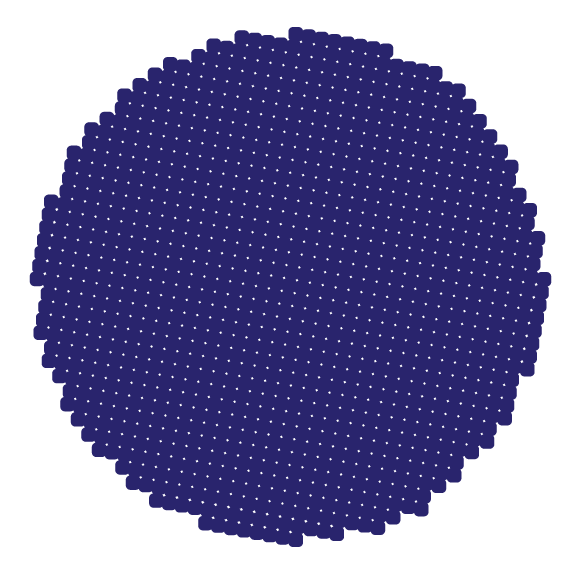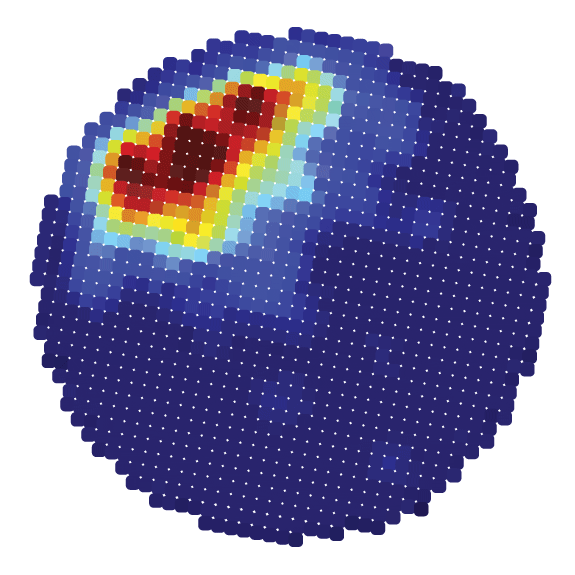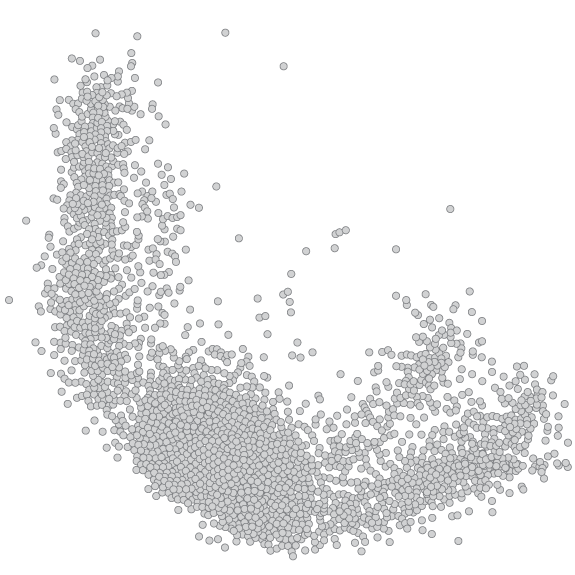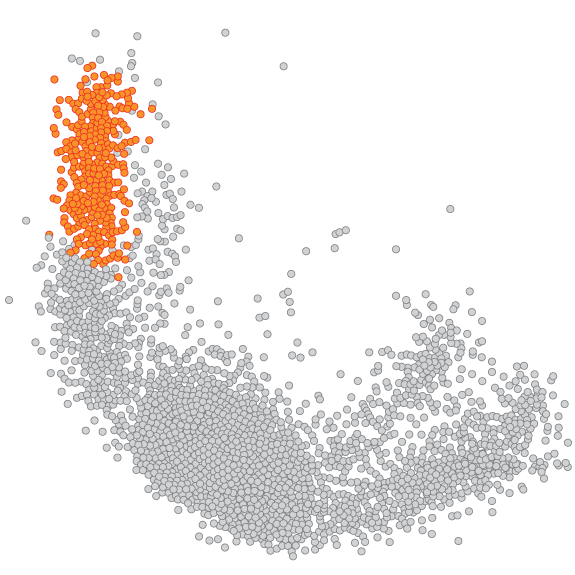When British physiologists Alan Lloyd Hodgkin and Andrew Huxley first quantitatively described the action potential from a squid neuron in 1952, they initiated decades of work by researchers to uncover the significance of these action potentials for the function of the nervous system.


The images above represent the firing of a ‘place’ cell as an animal explores its environment. Above image: A place cell fires more frequently when the animal reaches a particular location in its round environment; warmer colors indicate increased firing.
Below Image: While the animal explores the environment, spikes are recorded from many different cells, with each circle
representing the firing of a cell in the brain. Advanced sorting algorithms identify which spikes came from the place cell, shown in red. Techniques used to capture these data are at the cutting edge of neuroscience research and are central to the work of many SCGB investigators. Images adapted from Aronov D. and D. W. Tank, Neuron 84, 442-456 (2014).


Nearly half a century later, scientists have mastered the ability to trigger action potentials in single cells. While data from single cells are valuable, much remains unknown about how the brain’s neurons are connected into networks, how those networks are connected to one another, and how interactions between neurons and networks lead to thoughts and behaviors. Between triggering a single neuron and observing a discrete behavior, neurons and neural networks produce internal brain states — interacting with each other, performing computations and generating activity — processes that researchers have just begun to decipher.
The Simons Collaboration on the Global Brain (SCGB) aims to achieve a comprehensive and mechanistic understanding of brain processes. Using new technologies that allow researchers to record activity from thousands of neurons simultaneously in the brains of awake, behaving animals, 64 investigators and 93 postdoctoral fellows are studying a variety of brain regions, a range of animals and a diverse set of questions in labs around the world.
By collecting data from the activity of many neurons concurrently, SCGB investigators are getting closer to understanding the codes used by relevant neural circuits and how they produce behavior. This deeper understanding of how the brain produces cognition will shed light not only on observable behaviors like movement, but eventually, based on a comprehensive understanding of how neuronal networks function and interact, on the brain’s most elusive and unobservable activities: planning, motivation, judgment, memory, emotion and other aspects of reverie that may function even in the absence of obvious external stimuli.
“We know a lot about individual neurons and we know a lot about behavior, but we don’t know what happens in the middle,” says Alyssa Picchini Schaffer, scientific officer for the SCGB. “Understanding how neural circuits take inputs, make sense of them and then create outputs primes us for a deeper understanding of how the brain works.”
Capturing activity of all neurons in the entire brain. Using new imaging techniques, SCGB researcher Mischa Ahrens and colleagues captured neuronal activity from all (approximately 100,000) neurons in the entire brain of a larval zebrafish. This is the first instance of exhaustive imaging of cellular activity in the whole brain of a vertebrate. Now, the Ahrens group is recording brain-wide cellular activity from zebrafish while animals perform tasks. Information from these experiments will help researchers understand communication between large populations of neurons across multiple brain areas, moving them closer to a mechanistic understanding of brain function. Video reproduced by: Ahrens et al (2013). Nature Methods, 10(5), 413-420.
Once SCGB investigators achieve a more mechanistic understanding of the brain, they will begin examining the neuronal processes that drive externally unobservable activities, hoping that general principles will emerge. For example, neuronal computations for planning may be similar regardless of what is being planned.
“The ability to study the idea of movement, the planning of movement, before a subject actually moves has been elusive and mysterious,” says Gerald D. Fischbach, chief scientist and fellow of the Simons Foundation. “Because issues of internal states are no longer simply a matter of philosophy, scientists will be able to study what is going on in the brain that is responsible for these ideas and thoughts.”
The collaboration brings together experimentalists — who study various aspects of brain activity in a range of brain regions and in a variety of species, collecting vast amounts of data — and theorists — who create and apply statistical analyses to those massive datasets in an effort to decipher and guide the work of experimentalists. By incorporating biophysical properties of neurons into the data, theorists can create mathematical models of how neurons may assemble into circuits in the brain. Models created by theorists may drive experimentalists’ questions, helping frame the way researchers approach the data.
Together, the experimentalists and theorists hope to gain a comprehensive picture of healthy brain function. And once researchers have a solid mechanistic understanding of healthy brain function, members of the SCGB hope to better understand disordered brain activity and its potential treatment.
“These are big questions … and the brain is a big place,” says David Tank, director of the SCGB. “The challenges of understanding the brain are never going to be solved by individual labs. They’re just too hard. It’s through cross-fertilization of different individuals’ ideas from different perspectives that we’ll figure these things out.”




